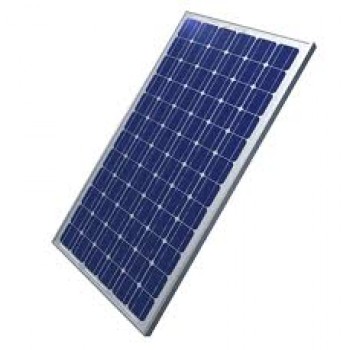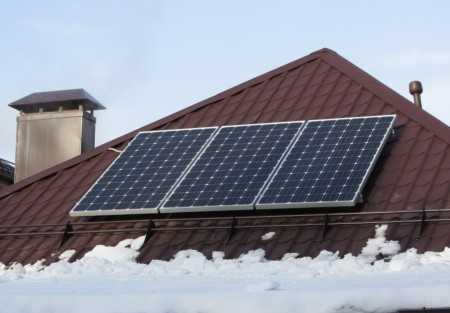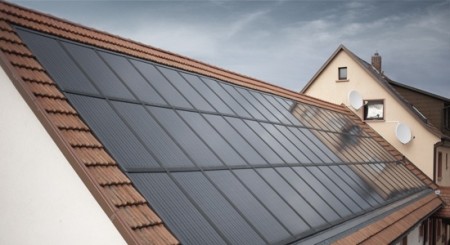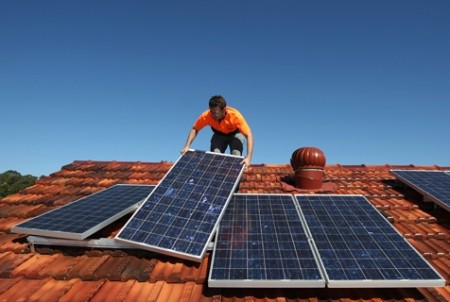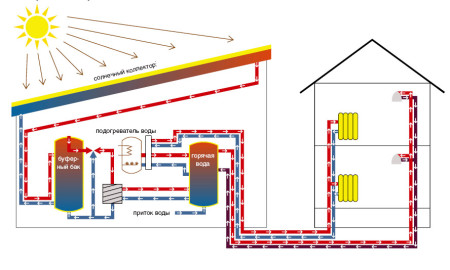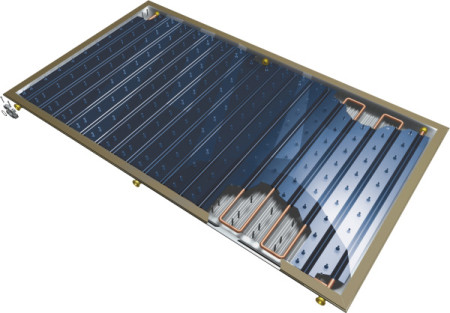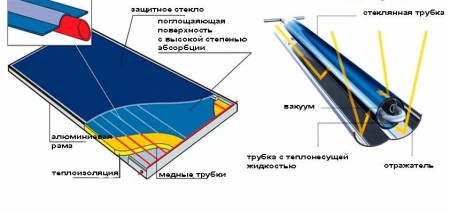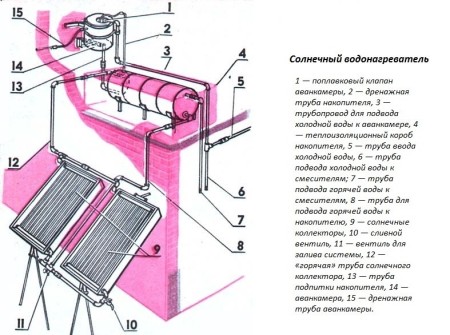"Modern technologies do not stand on the spot, and we are forced to keep pace with the times" - no matter how stereotyped and beaten the phrase may sound, but in the field of obtaining energy from natural phenomena, it is very relevant. People use the energy of water, wind, and the sun to get energy. Solar energy is an inexhaustible resource and an effective source of heat, which, unfortunately, is used very little in our country. Until recently, solar panels because of their huge cost were almost inaccessible to most people. Today the situation has changed for the better, and more and more people are interested in alternative sources of energy to provide heat and electricity to their homes. Below we will tell you whether you can warm your house with the help of the energy of the Sun, and how to do it.
Content
Solar battery - what is it?
Simply put - a converter of sunlight into a constant electric current in its pure form. The direct current can be converted into an alternating inverter by means of a special inverter, and it can be used as in a conventional household network. Solar batteries are far from a new invention, and even in Soviet times it was possible to buy a calculator on solar batteries. The energy of the Sun in domestic and even industrial uses is used abroad for a long time, that is, nothing new is needed to invent, but only to take advantage of the accumulated experience.
Advantages of solar heating, important points
Heating houses are very expensive - with this no one will not argue. Heating with solar panels will allow you to:
- Get almost complete independence from household electricity, ideally - do not pay for electricity and heating a penny.
- Adjust the temperature in the apartment or house on your own.
- Have your own free energy reserve, surpluses of which can be sold to the state. For example, in Ukraine there is a so-called "green tariff", according to which surplus energy received from alternative sources can be sold to the state at a rather high price.
- Solar panels are long, up to 25 years or more. This will relieve you of the hassle of replacing and repairing them, and for most of their lifetime you only benefit.
However, there are a number of important points that need to be read before running to buy and install equipment for solar heating at home. So, if you are unlucky to live in a region with a small number of sunny days, then the equipment is unlikely to fully provide your home with the energy you need.
Solar kits are expensive. So, to provide a medium-sized house with energy, you will need batteries with a total area of approximately 20 sq.m. If we take into account that on average, one square meter of a solar battery generates 120 watts, then a family of three will need a lot of batteries. Elements should be installed on the most illuminated part of the roof or section. As a rule, this is the southern and southeastern side.
If the installation is made on the roof of the building, then its area should be at least 40 sq.m. To get about 500 kW of energy a month, and a full-fledged system, at least 20 sunny days a month are needed. Near the house there should be no tall trees and buildings, the shadow of which will interfere with the operation of solar panels. The rafters on the roof of the house must be very strong to withstand the weight of the solar array and not break. This is especially true if a large amount of precipitation falls in your region in winter.
And, finally, the cost. To fully supply your home with electricity, you need to buy, for example, a 7 kW plant, make solar-powered heating - electric or water - all this will cost at least 200,000 rubles. But, payback is quite high - within 2-3 years. Then you get only a net benefit. The capacity of such an installation is completely sufficient to fully supply the house with an average value with heat and electricity.
Kinds of solar batteries, a complete set
Today, you can use two types of batteries for electricity generation - large and small photovoltaic systems. A small system is a panel with a battery, it makes it possible to get voltage from 12 to 24 volts.
Several such batteries can ensure the operation of the TV and full house lighting. A large photovoltaic system provides the house with energy and heat in full.
In terms of equipment, solar heating includes: a solar vacuum collector, a controller that monitors the operation of the system, a pump supplying a heat carrier to the storage tank, one or more tanks with a total volume of 500-1000 liters, a heat pump, or an electric tee. Having powered a powerful heating of a private house from solar panels, you get the opportunity to constantly use hot water, and, if desired, equip the "warm floor" in all rooms.
Before buying and installing the system, it is necessary to calculate its power. This takes into account the number of people permanently living in the house, the living space, the average energy consumption. So, on average, a family of three people spends 200 to 500 kW of energy per month on the use of household appliances. To this amount, it is necessary to add energy consumption for the constant heating of water in the heating system. The easiest way to calculate the area of solar panels, based on 1 square meter of solar cells per person. For example, if the house has warm floors, then for every 10 sq. Km. m. The floor will need energy from 1 square. m solar battery. And, again, do not forget:
- Batteries are installed on the sunny side.
- Nearby there should be no trees and tall buildings.
- The angle of the roof slope must be at least 30 degrees.
- The number of sunny days per month is not less than 20.
Insolation (irradiation of the earth's surface by solar radiation) is calculated from the calculation of 1000 kW / h per 1 sq. M per year. In this case, the amount of energy received is equivalent to the energy from 100 liters of gas. Some expensive powerful systems can easily provide hot water to a family of four, while having an area of slightly more than 4 square meters. m.
If you decide to install solar heating, remember that in the winter season, it is likely not to fully cope with the work. Therefore, it is strongly recommended not to completely abandon housing and communal services. This will give you the opportunity to hedge if the batteries do not get enough light to work properly.
Selection and installation of solar heating
To get an efficient and long-lasting heating system, you need to seriously approach its choice. Be sure to contact the specialists - they will help calculate the power and area of the system, help you choose the place for installation. Remember that batteries are expensive, and bought for decades. The system is installed in the maximum illuminated area, the permissible angle of deviation to the east or west is not more than 30 degrees.
The system of solar heating of houses can also be installed on the next building, if your not suitable for any reasons. The drive can be installed in the basement. It can also be delivered in parts, and assembled on site. Quite often a system is assembled from several smaller drives if there is no possibility of installing one large one.
An important point: solar heating will work more efficiently if the heating temperature is small. In this case, the optimal option - a panel heating system at home. To save energy in a timely manner, take care of the proper warming of your house.
The energy of the sun is free and inexhaustible, and the option of heating a private house with solar panels is not the only possible option. Today, for the same purpose, solar collectors are actively used, what it is, and how they differ from batteries - about this below.
solar collector
Both the solar battery and the collector use the same source of "recharging", but these are devices of different types. Solar panels can be used not only for heating, since they produce electricity. The collector is used only for heating, it produces only heat. The sun heats the water in the collector, which then enters the heating system. The solar collector can be produced on its own, today many craftsmen are doing this, and quite successfully, some put this business on stream, while earning good money.
To make a solar collector, there is no need to use expensive fragile photocells. What is the collector arrangement? Roughly speaking, it's just a radiator, placed in a box with a glass front wall, only the water in it does not cool, but warms up.
The system consists of three main elements:
- A solar panel.
- The Avancamera.
- Accumulation tank.
The system is installed in a well-lit place, most often on the roof. Heated water in the radiator, due to expansion comes in the vestibule. There it displaces cold water. Thus, a constant pressure in the heating system is maintained. The radiator should be placed, like a solar battery, on the south side of the roof, the slope of which should be from 30 to 45 degrees. The inner part of the box, into which the radiator is placed, and the radiator itself is painted black.
The work of the solar collector is based on the thermosyphon process - heated water changes its density, expands, and begins to move inside the system, displacing cold water. For such heating, a pump is not needed, water moves through the system on its own.
Solar collector for heating the house with your own hands - general advice and recommendations
To make a solar collector yourself, you can use a variety of materials. All elements of the system are made separately, after which they are connected by a pipe system.
manufacturing of a solar panel
It will take a box and material for the radiator. The box can be made of boards or plywood, after which the bottom and walls must be insulated as best as possible - for example, by foam.
For the manufacture of the radiator segments of wide pipes are used, which are welded together by segments of smaller diameter - as in a battery of steam heating. The top of the box is covered with a sheet of glass. The outer part of the box is painted white.
manufacture of an outpost and a storage tank
To do this, you need a pair of containers of suitable volume. For the drive you need a tank of not less than 150 liters. The tank is also insulated, for example, it is placed in a wooden box, the empty space is filled with heat-insulating material.
For the vestibule, a smaller tank is required, no more than 40 liters. The container must be completely sealed and equipped with a ball valve for water supply.
system assembly
Once the basic elements are ready, you can proceed with the assembly. First, the pre-chamber and the storage tank are installed. It is necessary to correctly calculate the water level in the tanks. The level in the pre-chamber should be above the level in the drive by at least 80 centimeters. When installing the solar panel, remember: it should be located at the lowest point of the system, the storage tank is higher, the vestibule is at the highest point. The distance from the panel to the storage tank must be at least 70 centimeters.
Then mount:
- Drainpipe storage.
- Drainage pipe of the vestibule.
- Cold pipe feeding pipe to the pre-chamber.
- Cold water inlet pipe.
- Cold water supply pipe to mixers.
- Hot water supply pipe to mixers.
- Hot water supply pipe to the storage tank.
- Hot radiator pipe.
- Piping tube for the storage tank.
For sections of a high-pressure system, it is better to use a pipe with a cross-section of half an inch, with a low-in-inch pipe. For fitting the system, suitable fittings, drifts, threaded connections, etc. are used for each specific case.
Before starting the system, it is filled with water through the drainage holes located below, after which the pre-chamber is connected to the heating system, and the water level in the reservoir is regulated. It is recommended to install valves at the bottom of the system to eliminate air congestion. If the system does not leak, you can start operating.



